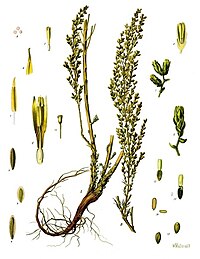
Photo from wikipedia
Abstract Using combined chromatographic methods, two new sesquiterpene glucosides, vulgarosides A (1) and B (2), and two known analogs ainsliaside E (3) and pumilaside A (4) were isolated from the… Click to show full abstract
Abstract Using combined chromatographic methods, two new sesquiterpene glucosides, vulgarosides A (1) and B (2), and two known analogs ainsliaside E (3) and pumilaside A (4) were isolated from the aerial parts of Artemisia vulgaris. Their chemical structures were established by spectroscopic methods, including one and two-dimensional nuclear magnetic resonance (1 D and 2 D-NMR) spectroscopy and high-resolution electrospray ionization mass spectrometry (HR-ESI-MS). In addition, their cytotoxicity on five human cancer cell lines, including KB (epidermoid carcinoma), HepG2 (hepatocarcinoma), MCF7 (breast carcinoma), SK-Mel-2 (melanoma), and LNCaP (prostate cancer) was also evaluated by the SRB assay. However, none of the tested eudesmane sesquiterpene glycosides showed significant cytotoxicity (IC50>100 µM). Graphical Abstract
Journal Title: Natural Product Research
Year Published: 2022
Link to full text (if available)
Share on Social Media: Sign Up to like & get
recommendations!